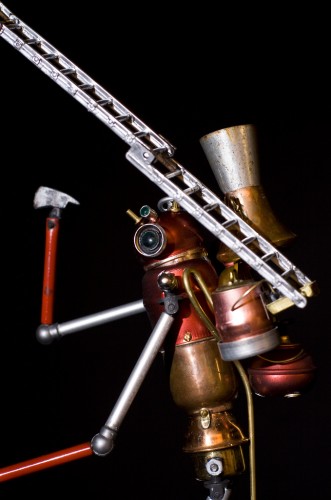I’ve got to yell you, sometimes writing about this stuff feels like cheating. I mean, the “conventional wisdom” about how to eat — the world according to the food pyramid, in other words — is wrong in so many ways that it’s sort of like shooting fish in a barrel. Everywhere I look there’s a piece of conventional wisdom to take apart.
Lets take calories for instance. We all know* that the way to lose weight is to eat less and exercise.
* NOTE: Whenever someone says “we all know”, the next thing out of their mouth is something that they can’t prove. That’s your first little life lesson. Look for another one coming up soon.
And we all know “eat less” means eat fewer calories. But …
What is a calorie?
A calorie is measure of heat. So when we say that a bag of crackers “has 100 calories” it means that if you put those crackers in a furnace, when you subtract the heat applied from the total heat produced you’ll end up with 100 calories. (Kilocalories, actually)
Read that definition again. I’ll wait …
Okay, got that? When we talk about how many calories a certain food has, we’re talking about how much heat is produced burning that food in a furnace
If you’re steam-powered, that might be a useful thing to know. Are you steam-powered? No? Didn’t think so.
So why are we measuring how well food burns?
You’re going to love this one. We’re measuring how well food burns because … it’s easy to measure. That’s it, full-stop. There is no evidence whatsoever that calories have anything to do with weight or nutrition.
Here comes that second life lesson I told you was coming: Sometimes we measure things because they’re easy to measure, not because they’re actually useful.
It’s like the old joke about the drunk looking for his keys under the streetlight. A cop asks him, “Is this where you had them last?” The drunk says, “No, but the light’s better over here.”
If measuring food in calories worked the way we’ve been taught to think of it, eating 100 calories of sugar (about an ounce) would be the same as eating 100 calories of beef (about two ounces).
Think it’s that simple? Okay, here’s an experiment to show how even simple things can be surprisingly complex.
Try this at home
You’re going to make simple syrup. You’ll need it for mixed drinks on your weekly cheat day.
Get an empty jar, a cup of sugar, and a rubber band. Put a cup of water in the jar, then add the cup of sugar. Put the rubber band around the jar to mark the height of the water.
Now let the jar sit, stirring occasionally, until the sugar is all dissolved and the water looks clear again. You’ll note that the level has gone up.
As a reader told me on my other blog:
The level increases when the sugar is thoroughly dissolved because the sugar molecules are now distributed evenly throughout the solution instead of being concentrated in crystalline form.
As an interesting side note, even when mixing two liquids you can get an end volume less than the sum of the liquids’ two individual volumes. But that’s like, complicated, and I got a C in thermodynamics.
You can see how this went for me on my other blog.
What does this have to do with calories?
Well, not a whole lot, actually. It was just an example of how sometimes things that seem simple really aren’t. But it does get me to my point: What does burning food have to do with eating food? Not a whole lot, actually.
[private guest 3|guest 4|guest 5|guest 6|guest 7|guest 8|guest 9|guest 10]
Part 5: Eating is not a sport
[/private]


